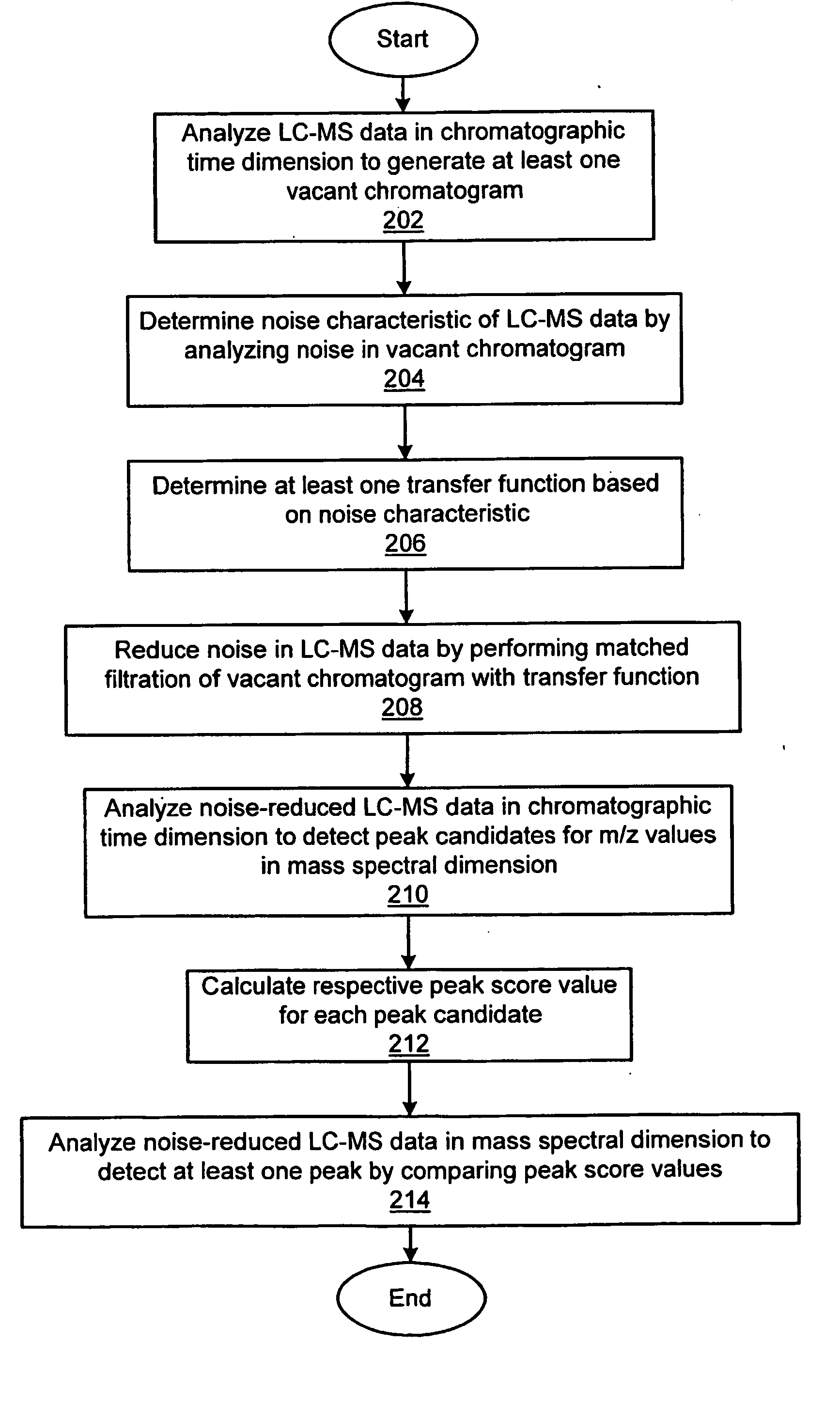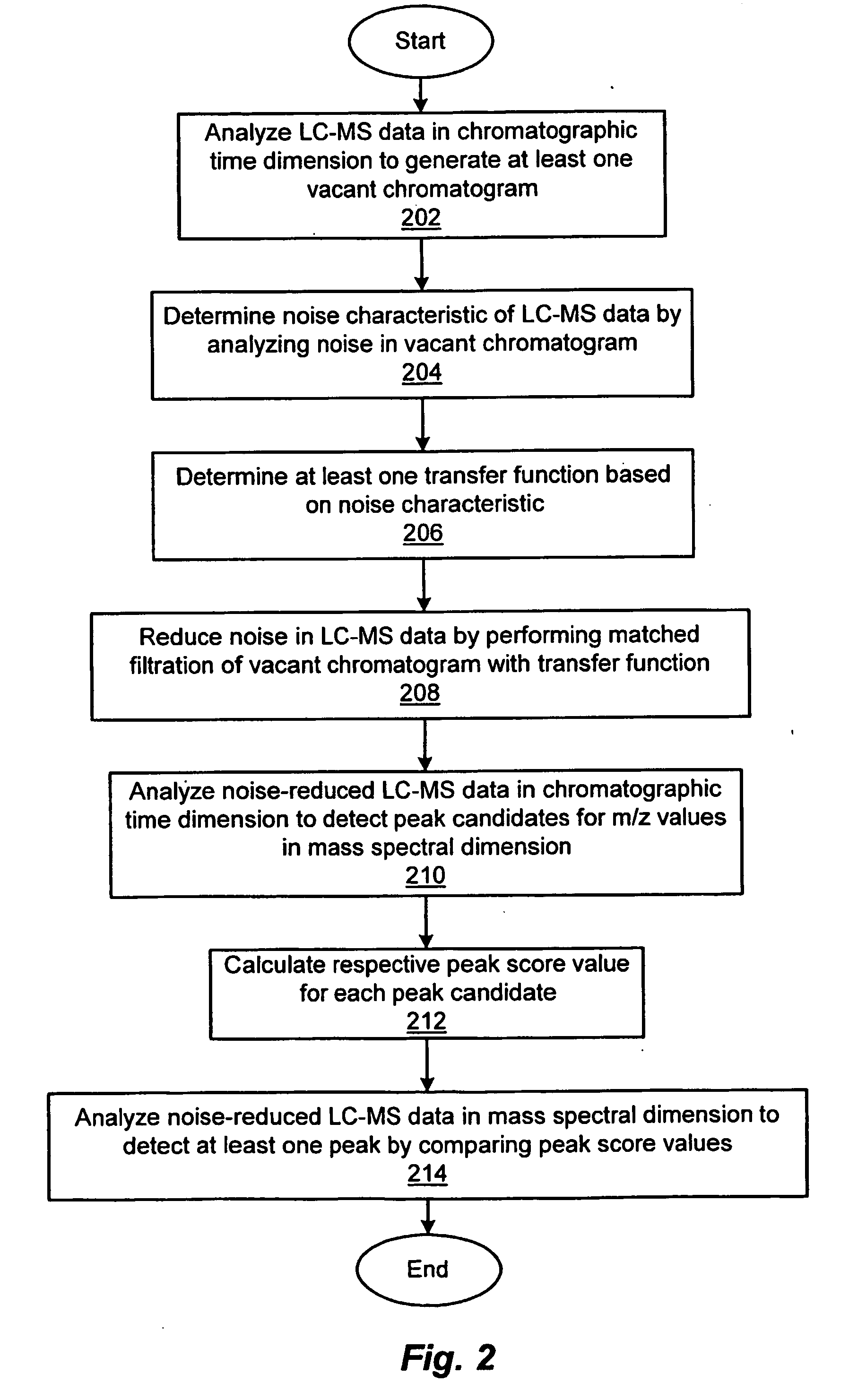Matched filtration with experimental noise determination for denoising, peak picking and quantitation in lc-ms
a technology of experimental noise determination and matching filtration, applied in chemical methods analysis, instruments, material analysis, etc., can solve problems such as difficult detection and identification of peaks, difficult detection of low intensity peaks, so as to reduce noise, increase reliability, and no distortion
- Summary
- Abstract
- Description
- Claims
- Application Information
AI Technical Summary
Benefits of technology
Problems solved by technology
Method used
Image
Examples
example 1
Noise Reduction in LC-MALDI-MS Data Sets
[0054] It should be appreciated that the suppression of chemical and random noise is important for the generation of accurate peak lists. FIGS. 3a-3d depict noise reduction of a typical mass spectrum from an LC-MALDI-MS data set produced by the analysis of a mixture of 10 standard peptides (see SAMPLES below, Sample 1). Specifically, FIG. 3a depicts a representative original spectrum corresponding to one second of chromatography resulting from averaging a signal from 150 laser shots; FIG. 3b depicts the result of moving-averaging of 10 consecutive spectra from the original data set (corresponding to 10 seconds of chromatography and 1500 laser shots); FIG. 3c depicts the result of noise reduction by cross-correlation of the Gaussian (i.e., matched filtration assuming random noise); and, FIG. 3d depicts the spectrum noise-reduced by matched filtration according to the method of FIG. 2 (i.e., using experimentally-determined noise characteristics...
example 2
Mass Accuracy in LC-MALDI-MS Noise-Reduced Data Sets
[0059]FIGS. 6a-6d illustrate the non-distorting character of the disclosed method, even for peaks with low S / N. In this illustrative example, the tryptic digest of a model mixture of 7 proteins (see SAMPLES below, Sample 2) is analyzed by LC-MALDI-MS. Further, the peak list is generated and used for selecting precursor ions for MS / MS analysis, and the results of MS / MS analysis are submitted to the MASCOT™ search engine, which is provided by Matrix Science Ltd., London, England. Thirty-nine peptides are identified. The sample is then diluted 5 times, and 5 standards are added to the matrix solution to provide mass calibration. Due to the combined effect of the dilution and ion suppression caused by the standards, the intensities of the MS peaks are significantly reduced, and only 12 of the 39 peptides identified at the first stage of experiment (high concentration sample) are subsequently detected at the second stage of experiment ...
example 3
Noise Reduction in LC-ESI-MS Data Sets
[0064]FIGS. 8a-8f depict an example of the application of the above-described method to the analysis of LC-ESI-MS data. In the case of 10 spectra averaging (see FIG. 8b), random noise is suppressed, but chemical noise with 1 Da periodicity is higher than in the original spectrum (see FIG. 8a). The noise-reduced spectrum (FIG. 8c) is essentially free of random noise and chemical noise. Peaks at m / z=426.01 and 428.00 are present in both the original spectra (see FIG. 8a) and the 10 averaged spectra (see FIG. 8b), but are absent in the spectrum noise-reduced by the above-described method (see FIG. 8c). As can be seen from the extracted ion chromatograms for these m / z values in FIGS. 8e-8f, the MS peaks are suppressed because they do not correspond to any chromatographic peaks. Rather, they result from the chemical noise due to some impurities of the eluent, and are therefore present in the broad chromatographic time region. The MS peak at m / z=413....
PUM
| Property | Measurement | Unit |
|---|---|---|
| concentration | aaaaa | aaaaa |
| dimension | aaaaa | aaaaa |
| liquid chromatography- | aaaaa | aaaaa |
Abstract
Description
Claims
Application Information
 Login to View More
Login to View More - R&D
- Intellectual Property
- Life Sciences
- Materials
- Tech Scout
- Unparalleled Data Quality
- Higher Quality Content
- 60% Fewer Hallucinations
Browse by: Latest US Patents, China's latest patents, Technical Efficacy Thesaurus, Application Domain, Technology Topic, Popular Technical Reports.
© 2025 PatSnap. All rights reserved.Legal|Privacy policy|Modern Slavery Act Transparency Statement|Sitemap|About US| Contact US: help@patsnap.com



